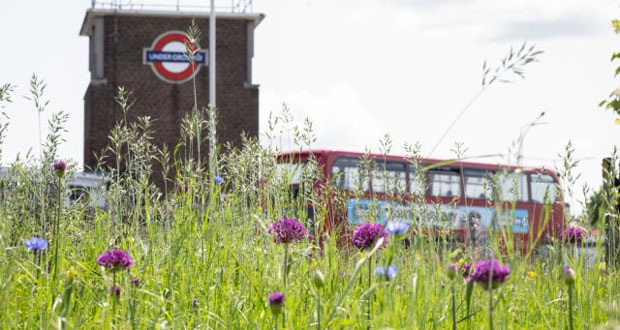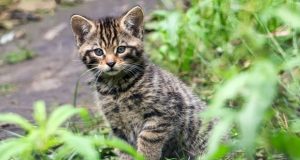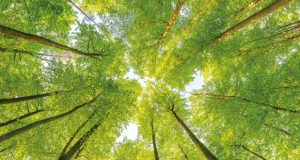Transport for London (TfL) has published a new Green Infrastructure and Biodiversity Plan, as part of its continuing work to become the “strong, green heartbeat” of the city.
London is home to a remarkable variety of plant and animal species. From its lush green parks and gardens to its riverbanks and woodlands, the city provides a wide range of habitats. Green infrastructure and biodiversity – the variety of all living things and their interactions – provide a wide range of important benefits, such as helping the city adapt to climate change and encouraging active travel.
The plan sets out how TfL will improve and care for green infrastructure and biodiversity across its estate and networks. It captures in one place, for the first time, its existing relevant targets, legal requirements and policy commitments, while also setting out the strategic actions TfL will take to deliver them.
This new plan will ensure TfL meets a range of commitments to further enhance and support green infrastructure and biodiversity across London, including:
- Achieving a 10 per cent biodiversity net gain on applicable schemes (i.e. planning system projects and Nationally Significant Infrastructure Projects) from February 2024
- Delivering a net gain in biodiversity across TfL’s estate by 2030, compared to the 2018 biodiversity baseline map
- Boosting tree canopy cover across TfL by 10 per cent by 2050, compared with the 2016 baseline
- Doubling wildflower verges to 260,000 square metres in 2024, and developing a longer-term plan to continue their introduction across London
- Ensuring 5,000 square metres of Sustainable Drainage Systems (SuDS), such as rain gardens, are installed on TfL’s road network each year
- Further reduce the use of pesticides across TfL and eliminate where operationally and financially feasible
As one of London’s largest landowners, with more than 2,300 hectares across the capital, almost a third of TfL’s land is covered by vegetation. This includes land which intersects two Special Areas of Conservation, six Sites of Special Scientific Interest, eight Local Nature Reserves and 139 Sites of Importance for Nature Conservation. TfL’s wide variety of habitats, from woodland to wetland, support more than 1,000 animal species – such as a range of butterfly species and eight different species of bat within a disused railway tunnel at Highgate – as well as almost 700 plant species across London. Many of the species found on or near TfL’s estate are legally protected and therefore it is important to protect their habitat.
In 2022, TfL was the first transport provider in the UK to carry out a natural capital account for its estate, which found that the benefits from TfL’s natural capital assets that can be monetised have a current estimated gross asset value of £328 million. While this is a significant figure, it is still likely to be an underestimate, and TfL is now planning on a range of biodiversity research and innovation projects to help fill in data gaps and improve future accounts.
Using this information, TfL will be able to make better decisions about how to manage its green infrastructure and increase biodiversity. TfL plans to double the area of wildflower verges alongside the TfL Road Network to 260,000 square metres in 2024. It will also explore potential ways to further increase biodiversity at these sites, which already support 17 different species of butterfly, five of which are London Priority species. TfL is also on track to meet its commitment to deliver an additional 5,000 square metres of Sustainable Drainage Systems (SuDS), such as rain gardens, on its road network each year. These nature-based solutions not only help support biodiversity but also help reduce the risk of flooding from storms.
Across London, TfL is also meeting its target to increase the overall number of street trees on its estate by one per cent per year between 2016 and 2025. A plan to help strategically increase tree canopy across TfL’s estate by 10 per cent by 2050 will be published by March 2025. Tree canopies provide shelter from the sun as well as habitats for birds and wildlife.
The health of soil across London can affect its capacity to hold or drain water, and its ability to support particular habitats. The plan outlines how soil on TfL land will be protected from degradation or contamination, reducing the need for additional resources, such as fertiliser and compost. TfL also plans to eliminate the use of pesticides where operationally and financially feasible, having already reduced highways glyphosate use by 70 per cent in recent years.
TfL plays a key role in not only helping to protect, connect and enhance green and canopy cover across its own estate, but also in assisting in making other green spaces, such as parks and recreation grounds, accessible to the public. Providing sustainable travel access can help reduce social and environmental inequalities, so to inform this work, TfL will be mapping sustainable travel access to London’s green spaces in relation to socio-economic factors by the end of 2025. This will help inform future investment decisions and ensure that those walking, cycling or taking public transport have clear and easy access to green spaces across the city.
Lilli Matson, Chief Safety, Health and Environment Officer at Transport for London said: “As one of London’s largest landowners, TfL has an extensive network of green corridors, from tree-lined streets to trackside woodland. Together, these play a crucial role in connecting London’s green spaces for wildlife.
“Our new Green Infrastructure and Biodiversity plan forms part of our continuing work in creating a greener, more biodiverse city that is resilient and well adapted to climate change. By lowering the environmental impact of our business and offering a range of sustainable ways to travel across London, we can use our real estate and infrastructure to create a city that allows people and wildlife to flourish.”
Over the past year, Eptura has used proprietary data and commissioned research to explore how business leaders can balance opposing demands.
In this final summary report on the state of the workplace in 2023, the global worktech leader looks at the key insights that will shape the world of work in 2024 and beyond.
For the Q4 edition of the 2023 Workplace Index, Eptura updated its proprietary data across four demands:
- Freedom and Connection
- Value creation and Cost Control
- Flexibility and Certainty
- CO2 Targets and Costs
To download the report click here.





